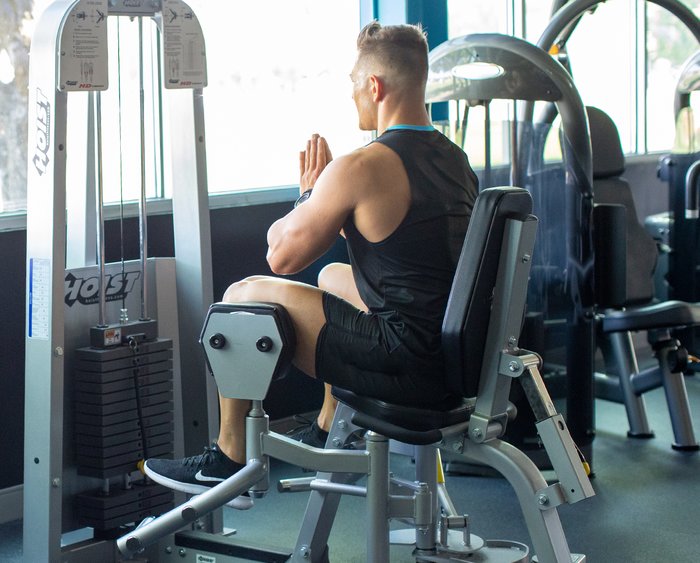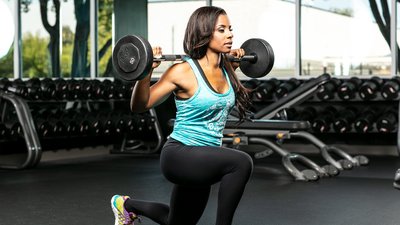With glutes having become "the new biceps," it's common for personal trainers, strength coaches, athletes, and everyday exercises enthusiasts alike to go hog-wild with exercises that focus on training the hip abductors—i.e., the glutes.
Want proof? Look no further than the lateral band walk, a movement that was pretty much never seen a few years ago, but is now about as mainstream as it gets. Need more proof? The very first move in the very first warm-up you do in the Bodybuilding.com BodyFit Elite program True Muscle: 9 Weeks to Elite Fitness, which I helped create, is the fantastic single-leg glute bridge. And you're doing it as part of a shoulders and abs day!
To be clear, I think all this new focus on the glutes is great—and by all means, check out my article "7 Game-Changing Glute Training Tips" to learn about better glute training. However, as is often the case with new exercise obsessions, it often comes at the expense of what's happening on the other side of the joint. In this case, that would be the hip adductors, or inner thighs.
The adductors will never be as sexy or powerful as the abductors, but they're essential for a strong, functional lower body. Plus, it's never a good idea to completely focus on one muscle or motion, and do nothing at all for its opposite.
Here are my science-backed reasons why it's important not to neglect training your adductors, and a couple of the best (and most difficult) adductor training exercises you're probably not doing.
Why Use Hip Adductor Exercises?
A 2015 systematic review (a study of studies) published in the British Journal of Sports Medicine found that hip adductor strength was one of the most common risk factors for groin injury in sport.[1]
Interestingly, research on professional ice hockey players also found that they were 17 times more likely to sustain an adductor muscle strain (i.e., groin injury) if their adductor (muscles that move your leg toward the body's midline) strength was less than 80% of their abductor (muscles that move your leg away from the body's midline) strength.[2]
No, you're probably not a pro hockey player, but I've got news for you: Groin injuries are also very common in the gym, and in life, and they can be a bear to heal from.

So, with this evidence in mind, it stands to reason that complimenting your training of the muscles that contribute to hip abduction by also regularly incorporating exercises to improve the strength of the hip adductors will not only help to make your training programs more comprehensive, but also may help to reduce the risk of suffering a groin injury.
Wide-Stance Squats and Single-Leg Exercises Aren't Sufficient!
Many personal trainers and strength coaches are under the impression that you don't need to do specific isolation exercises to target your adductors, since compound exercises like squats and lunges do the job effectively. However, the research in this arena doesn't necessarily paint that same training picture.
A review investigating the barbell squat found that a greater hip external rotation position (i.e., feet turned out) along with a wide stance of the feet increased hip adduction activation during this exercise. As weights got heavier, the activation went up more.[3] However, the highest activation values for this movement, as well as for single-leg squats and lunges, are still relatively low compared to exercises that focus primarily on the hip adduction movement.[4,5]
In other words, incorporating some adductor isolation exercises into your workout, along with compound exercises, can make your training more comprehensive and effective. And unlike lots of heavy, wide-stance squats, you can add it to your workout with pretty much no further impact on your recovery or other training.
Two Prerequisite Exercises to the Copenhagen Hip Adduction
The standard exercises to train the hip adductors are pretty well-known: standing hip adductions with a band or cable attached to your ankle, and the seated hip adduction machine. In my training experience, I prefer a different move: The Copenhagen hip adduction exercise.
However, not everyone will be able to perform the Copenhagen hip adduction exercise well, because it is a pretty advanced move that requires you to be proficient at holding yourself in a strong and stable side-elbow plank position. And, also is very demanding on the adductor musculature in both the top and bottom leg.
So, before you try the Copenhagen—which I'll show how to do later—start with these two moves.
Side Elbow Plank With Hip Flexion
This exercise not only improves your side-plank strength, but it forces you to use the adductors of your top leg to hold you up while also teaching you how to be able to move at your hip (of the bottom leg) without losing your straight-body alignment.
- Perform 2-3 sets of 8-15 reps per side, with a 1-2 second pause at the top of each rep.
Side-Lying Hip Adduction Scissor
Since the previous exercise focuses on the adductor musculature of the top leg to maintain the position, along with the torso musculature, this exercise focuses on the adductor musculature of the bottom leg. A warning: This exercise is harder than it looks.
- Perform 2-3 sets of 12-20 reps per side, with a 1-2 second pause at the top of each rep.
If you're able to perform both of the exercises for the above sets and reps in good technique, you're ready and capable of performing the Copenhagen hip adduction exercise with good control and technique.
The Copenhagen Hip Adduction Exercise
Put simply, the Copenhagen hip adduction exercise has been shown to be a very effective movement for training hip adductors.[6,7] It's certainly one of my favorite exercises for targeting the hip adductors, along with the additional shoulder and torso musculature demands.
This is how I perform the Copenhagen hip adduction exercise, which is a bit different than it's commonly done. The exercise is often demonstrated with a training partner holding the lifter's top leg underneath your top knee and foot. Without a partner, keeping your top leg straight and placing your top foot on the end of a platform or plyo box exposes you to additional lateral forces through your knee joint that are greatly reduced when the partner is also holding your knee. Don't do that!
Using my version, you don't need a partner, because placing the bent knee on top of the platform allows you to reap the same benefits while providing more support at your knee joint.
I also like to perform a version of it that incorporates adduction leg scissors, and isometric holds, similar to the style of training in my article "Smart Dumbbell Lifting: Iso-Dynamic Training."
Regardless of which variation you perform, here are some coaching tips to keep in mind when performing this exercise:
- Place a rolled-up towel or mat both underneath your leg that's atop the platform and underneath your bottom elbow for comfort.
- Keeping your right leg straight and your body in a straight line from your left knee to your hips to your shoulders, press your left leg into the top of the platform as you elevate your right hip off the ground. Simultaneously lift your right leg up to squeeze the inside of your right thigh against the inside of your left thigh.
- Pause for 1-2 seconds at the top before reversing the action and lowering your right leg and hip back down to the floor. That completes one rep.
- Do all reps on the same side before switching sides and performing the exercise with your right leg on top of the platform.
In term of sets and reps, I generally recommend doing 2-3 sets of 8-15 reps per side. Once you can do that, you'll have earned seriously strong thighs, and taken serious steps to bulletproof your lower body.
References
- Whittaker, J. L., Small, C., Maffey, L., & Emery, C. A. (2015). Risk factors for groin injury in sport: an updated systematic review. Br J Sports Med, bjsports-2014.
- Tyler, T. F., Nicholas, S. J., Campbell, R. J., & McHugh, M. P. (2001). The association of hip strength and flexibility with the incidence of adductor muscle strains in professional ice hockey players. The American Journal of Sports Medicine, 29(2), 124-128.
- Pereira, G. R., Leporace, G., das Virgens Chagas, D., Furtado, L. F., Praxedes, J., & Batista, L. A. (2010). Influence of hip external rotation on hip adductor and rectus femoris myoelectric activity during a dynamic parallel squat. The Journal of Strength & Conditioning Research, 24(10), 2749-2754.
- Clark, D. R., Lambert, M. I., & Hunter, A. M. (2012). Muscle activation in the loaded free barbell squat: a brief review. The Journal of Strength & Conditioning Research, 26(4), 1169-1178.
- Dwyer, M. K., Boudreau, S. N., Mattacola, C. G., Uhl, T. L., & Lattermann, C. (2010). Comparison of lower extremity kinematics and hip muscle activation during rehabilitation tasks between sexes. Journal of Athletic Training, 45(2), 181-190.
- Serner, A., Jakobsen, M. D., Andersen, L. L., Hölmich, P., Sundstrup, E., & Thorborg, K. (2013). EMG evaluation of hip adduction exercises for soccer players: implications for exercise selection in prevention and treatment of groin injuries. Br J Sports Med, bjsports-2012.
- Ishøi, L., Sørensen, C. N., Kaae, N. M., Jørgensen, L. B., Hölmich, P., & Serner, A. (2016). Large eccentric strength increase using the Copenhagen Adduction exercise in football: A randomized controlled trial. Scandinavian Journal of Medicine & Science in Sports, 26(11), 1334-1342.

